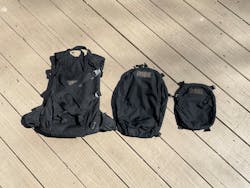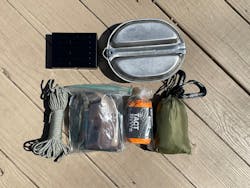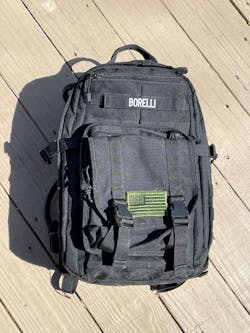Survival Packs On OR Off Duty
Due to changes in the industry, that pack is no longer available, but I still have it in my equipment closet and it still goes with me on hikes. Working security in New Orleans after Hurricane Katrina went through taught me the value of always having some emergency supplies with me. Shelter, an emergency poncho, a “space blanket” bivvy, some food supplies, fire starting materials, water and more—it’s all in that one pack.
In today’s market, there are a number of manufacturers of quality packs and I would encourage every reader to examine their need for one. Whether it’s a RUSH2.0 of any size from 5.11 Tactical, a Stingray from Blackhawk or one of the Maxpedition Prepared Citizen line if it holds what you need, you should consider the value of having one with you—or at least accessible when you need it. Life shows that “when you need it” is when you will least expect it.
On duty, that will be when you get held over on a shift to sit on some remote perimeter position for hours. Off-duty it’ll be when you trip over a root you didn’t see while hiking and end up with a twisted ankle. An injury can easily prevent you from making your return trip as scheduled and spending the night in the wilds with zero supplies is not fun. The emergency supplies are not hard to come by and can be had for few dollars if you shop around. Your local surplus shop and Walmart are you friend.First make sure your hydration bladder is clean and filled. Having an inline filter helps you keep it that way without fear of dysentery. A surplus poncho, some 550 cord and four small aluminum stakes allow you to make about 50 different kinds of shelter dependent on need. A mylar “space blanket” bivvy—one that wraps around you like a sleeping bag—can help retain as much as 90% of your body heat. A few protein, granola or other snack bars can provide the calories you need to get through a day or keep you from suffering some ugly hunger pains if you have to go longer than that. A tourniquet, a pressure bandage and maybe a pack of hemostatic agent can keep you from bleeding out if you get a severe laceration or puncture wound. A knife, a flashlight and maybe some chem lights should be included. Make sure you have some fire-starting materials and you’re set to have an unexpected overnight out in the woods be less miserable.
For more information, research “ultralight backpacking” and see what’s out there. A pack designed for a minimum of 24 hours is perfect: it’s not so large as to be inconvenient, but it’s large enough to carry everything you will need. Remember: you’re not going for comfort. You’re going for survival.

Lt. Frank Borelli (ret), Editorial Director | Editorial Director
Lt. Frank Borelli is the Editorial Director for the Officer Media Group. Frank brings 20+ years of writing and editing experience in addition to 40 years of law enforcement operations, administration and training experience to the team.
Frank has had numerous books published which are available on Amazon.com, BarnesAndNoble.com, and other major retail outlets.
If you have any comments or questions, you can contact him via email at [email protected].





